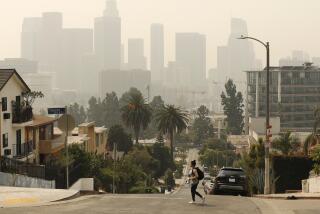EPA to Declare Passive Smoke Causes Cancer
- Share via
WASHINGTON — In a long-delayed decision that could eventually have a major impact on the American workplace, the Environmental Protection Agency on Thursday will conclude officially that exposure to “secondhand” cigarette smoke causes lung cancer in adults and greatly increases the risk of respiratory illnesses in children.
EPA Administrator William K. Reilly’s endorsement of a report by a panel of scientific advisers to the agency will end a contentious two-year review of the issue during which the panel’s evidence and conclusions have been denounced repeatedly by the tobacco industry.
The EPA’s endorsement of the scientific panel’s findings will have no immediate practical effect, because the agency has no authority to regulate indoor air pollution. But the move could have a significant influence on how local governments and the federal Occupational Safety and Health Administration adopt and enforce workplace anti-smoking rules.
OSHA is in the beginning stages of soliciting information on indoor air quality, a process that could lead to new federal rules on air pollution in the workplace. An OSHA spokesman said Tuesday that “it’s too early to tell” what the effect will be of the EPA’s designation of passive tobacco smoke as a human carcinogen but said the report will “feed into the process” of workplace rule-making.
The EPA’s scientific advisory panel finished its review of the subject in late October, approving a report which concludes that environmental tobacco smoke (ETS) is a “Class A” human carcinogen--a group that includes a handful of substances such as asbestos, arsenic and benzene. ETS, the panel estimated from a variety of studies, annually causes the lung cancer deaths of 3,000 U.S. adults.
The report also blames secondhand smoke for hundreds of thousands of cases of childhood respiratory illnesses, such as bronchitis and pneumonia, and for increasing the severity of asthma attacks in children.
Public health advocates hailed the news that EPA would take the final step in endorsing the scientific panel’s conclusions.
“This really puts the EPA imprimatur on something the public has known for a long time--that is, that secondhand smoke is dangerous, that tobacco smoke, whether inhaled from one’s own cigarette or someone else’s cigarette, is basically the same product,” said Alfred Munzer, a Washington-area lung specialist who is the incoming president of the American Lung Assn.
Munzer said the EPA’s endorsement could provide “further impetus” for the passage of workplace smoking bans by local and state governments. He also urged President Bush to ban smoking in all federal buildings through an executive order.
Tom Borelli, director of scientific affairs for cigarette maker Phillip Morris, said that EPA’s statistical basis for assessing the risk of environmental tobacco smoke was flawed and that the agency ignored studies that conclude that the risk of secondhand smoke is statistically insignificant.
“They’ve adjusted the science to fit policy,” Borelli said. “Clearly, any issue dealing with tobacco is a very, very emotional issue. Sometimes emotion can override science. This (report) is politically correct.”
Among the flaws in EPA’s assessment of the risk of secondhand smoke, Borelli said, is its use of a recently popular statistical technique called meta-analysis--a method used to integrate the findings of many studies of different designs into a single result. “This was a precedent-setting risk assessment, the first time EPA ever used meta-analysis.”
An EPA official disputed Borelli’s criticism, saying the agency had used the meta-analysis technique at least once before.
In its final draft of the report, the EPA’s scientific advisory committee, which twice reviewed the overall conclusions and methodology, defends its work: “The revised draft has an improved presentation, discussion and analysis of ETS as a lung carcinogen . . . . The committee was unanimous in endorsing this classification.”
More to Read
Sign up for Essential California
The most important California stories and recommendations in your inbox every morning.
You may occasionally receive promotional content from the Los Angeles Times.













